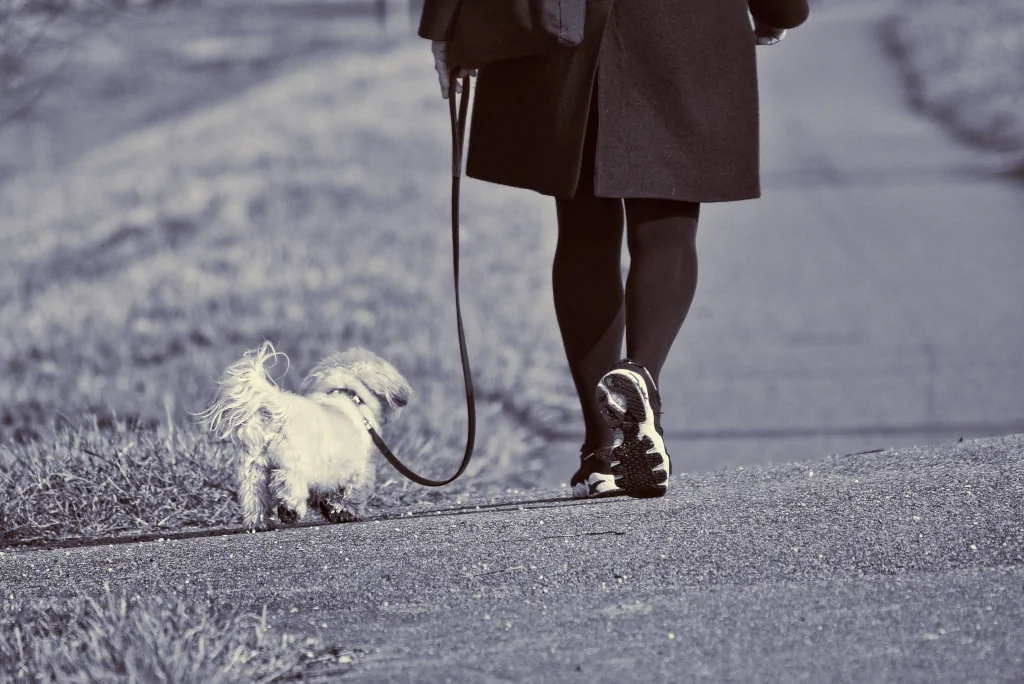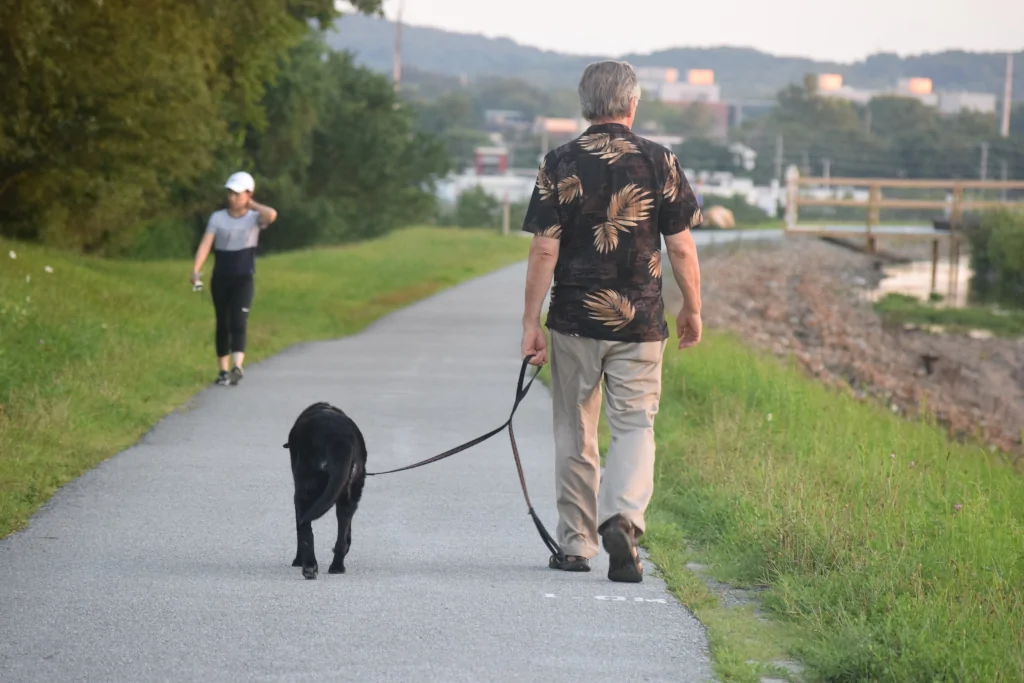Disclosure: We may earn a commission from helpful, relevant links in our content. No cost to you. See our privacy policy.
Tired of being dragged around the block by your overenthusiastic furry friend?
Longing for peaceful strolls, where you can both enjoy your surroundings and connect with your canine companion?
You’re in the right place. Like you, many pet owners struggle with teaching their dogs to walk calmly on a leash, making daily walks a test of endurance rather than a relaxing stroll.
But don’t worry, mastering the art of loose leash walking is possible, and we’re here to help you transform those chaotic walks into enjoyable bonding experiences with your canine companion.
For general leash walking tips, follow this guide.

What Is Loose Leash Walking and Why Is It Important?
Loose leash walking is a skill that teaches your dog to walk calmly by your side without pulling or tugging on the leash.
Achieving this not only brings harmony to your daily walks but also keeps both you and your dog safe from potential accidents or injuries.
Imagine strolling through the park, your dog happily trotting beside you, taking in the sights, and leaving you free to enjoy the moment together – that’s the power of loose leash walking.
Additionally, loose leash walking fosters a stronger bond between you and your dog by promoting trust and clear communication, ensuring that your daily strolls are a pleasant experience for both of you.
Getting Started: The Right Equipment
Before diving into loose leash walking training, you’ll want to make sure you have the right equipment so you can make sure you’ll achieve success.
A flat collar or a front-clip harness is recommended, as they allow for better control and discourage pulling.
Along with this, choose a sturdy leash that’s 4-6 feet in length, which provides enough freedom for your dog to explore while still maintaining control.
Avoid using retractable leashes, as they can inadvertently encourage pulling and make it harder to teach your dog the desired behavior.
Our guides:
Techniques for Teaching Loose Leash Walking
Choose a Cue Word or Signal
Select a cue word or signal to indicate it’s time for loose leash walking, like “heel,” “walk,” or a specific hand gesture.
Consistently use this cue throughout the training process to help your dog associate the word or signal with the desired behavior.
Begin in a Calm Environment
Start training in a low-distraction environment, such as your backyard or a quiet indoor space. This allows your dog to focus on learning the new behavior without being overwhelmed by external stimuli.
Use the Concept of Pressure and Release
Teach your dog to yield to pressure by gently applying tension to the leash and rewarding them when they move towards you, releasing the tension.
Practice this in various situations to help your dog understand the concept of maintaining a loose leash.
Utilize the “Penalty Yards” Technique
When your dog pulls, calmly walk backward and have your dog follow you, effectively losing the ground they gained by pulling. Gradually increase the distance you walk backward as your dog gets better at responding to this technique.
Employ the “Red Light, Green Light” Method
As soon as your dog starts pulling, stop walking (red light). When the leash becomes loose, resume walking (green light). Over time, your dog will learn that a loose leash means they can continue moving forward.
Practice the “U-Turn” Technique
When your dog pulls, make an abrupt U-turn and start walking in the opposite direction. Change directions frequently to encourage your dog to pay attention to your movements and maintain a comfortable pace.
Reward Good Behavior
Use positive reinforcement to reward your dog when they’re walking calmly by your side with a loose leash. Offer treats, praise, or a favorite toy immediately after they show the desired behavior to reinforce the connection between the action and the reward.
Gradually Increase Distractions
Once your dog becomes more comfortable with loose leash walking in a controlled environment, introduce them to busier areas with more distractions.
This will help your dog generalize the behavior and apply it in various situations, ensuring a consistently enjoyable walking experience.

Addressing Common Issues: What if My Dog Pulls?
Consistency, patience, and positive reinforcement are crucial when addressing pulling issues. Keep practicing, and with time, your dog will learn to walk calmly on a loose leash. Consider also using training aids for leash pulling for easier walks.
Making Loose Leash Walking a Habit
I remember when I was training my dog, Charlie, to walk on a loose leash. We started with short, daily practice sessions in our backyard, gradually increasing the distance and introducing distractions.
One key to our success was finding Charlie’s favorite treat, which made him eager to walk by my side. By setting realistic expectations and celebrating small victories along the way, Charlie and I turned loose leash walking into an enjoyable routine, and you can too!
Therefore, to make loose leash walking a habit, practice consistently and reward your dog for good behavior.
Here are some more tips from Steve with an accent on good leadership as the foundation to teaching loose leash walking:
FAQs
At what age can I start training my dog for loose leash walking?
You can start training your dog for loose leash walking as early as 8 weeks old, but it’s never too late to teach an older dog new tricks.
How can I make loose leash walking enjoyable for my dog?
To make loose leash walking enjoyable for your dog, use positive reinforcement with treats, praise, and play, and keep training sessions short and engaging.
How long does it take to teach a dog loose leash walking?
With consistent practice, most dogs can learn the skill within a few weeks to a few months. However, the time it takes to teach a dog loose leash walking varies based on the dog’s age, breed, and temperament.
Can I use a specific collar or harness for loose leash walking?
Yes, using a well-fitted no-pull harness or a head collar can help manage pulling behavior and make loose leash walking training more effective.
Alex, a passionate animal lover, has experience in training and understanding animal behavior. As a proud pet parent to two dogs and three cats, he founded AnimalReport.net to share insights from animal experts and expand his knowledge of the animal kingdom.




